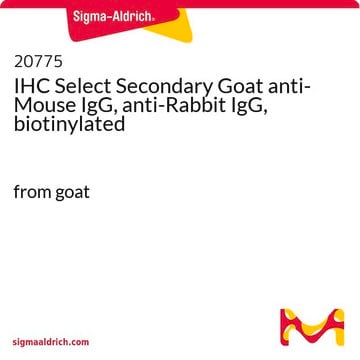21537
IHC Select Secondary Goat Anti-Rabbit IgG Antibody, prediluted, biotinylated
from goat, biotin conjugate
Sign Into View Organizational & Contract Pricing
All Photos(1)
About This Item
UNSPSC Code:
12352203
eCl@ss:
32160702
Recommended Products
biological source
goat
Quality Level
conjugate
biotin conjugate
antibody product type
secondary antibodies
clone
polyclonal
species reactivity
rabbit
manufacturer/tradename
Chemicon®
IHC Select
technique(s)
immunohistochemistry: suitable (paraffin)
shipped in
wet ice
target post-translational modification
unmodified
Application
Prediluted for use in Immunohistochemical staining procedures. For example:
Blocking Reagent
Primary Antibody (Rabbit IgG) or Negative Control Reagent
Biotinylated Secondary Antibody (Gt X Rb IgG)
Streptavidin-Enzyme Conjugate
Chromogen
Counterstain
For best results use this reagent in conjunction with other IHC Select detection reagents. A complete list of reagents is available at www.chemicon.com.
Blocking Reagent
Primary Antibody (Rabbit IgG) or Negative Control Reagent
Biotinylated Secondary Antibody (Gt X Rb IgG)
Streptavidin-Enzyme Conjugate
Chromogen
Counterstain
For best results use this reagent in conjunction with other IHC Select detection reagents. A complete list of reagents is available at www.chemicon.com.
This Goat IgG antibody is validated for use in IHC for the detection of the Rabbit IgG protein.
Physical form
Goat Anti-Rabbit IgG in PBS containing carrier protein, with 0.1% Kathon as preservative.
Legal Information
CHEMICON is a registered trademark of Merck KGaA, Darmstadt, Germany
Not finding the right product?
Try our Product Selector Tool.
Signal Word
Warning
Hazard Statements
Precautionary Statements
Hazard Classifications
Aquatic Chronic 3 - Skin Sens. 1
Storage Class Code
12 - Non Combustible Liquids
WGK
WGK 2
Flash Point(F)
Not applicable
Flash Point(C)
Not applicable
Certificates of Analysis (COA)
Search for Certificates of Analysis (COA) by entering the products Lot/Batch Number. Lot and Batch Numbers can be found on a product’s label following the words ‘Lot’ or ‘Batch’.
Already Own This Product?
Find documentation for the products that you have recently purchased in the Document Library.
Customers Also Viewed
Rui Zheng et al.
Molecular medicine reports, 22(3), 2351-2363 (2020-07-25)
One key risk factor of aortic valve stenosis in clinical practice is bicuspid aortic valve (BAV). Increasing evidence indicates that numerous microRNAs (miRs/miRNAs) are involved in BAV calcification via their target genes. miR‑330‑3p was found to be involved in the deterioration
Anke Mittelstädt et al.
Frontiers in immunology, 15, 1253072-1253072 (2024-06-07)
Pancreatic ductal adenocarcinoma (PDAC) is one of the deadliest forms of cancer and peritoneal dissemination is one major cause for this poor prognosis. Exosomes have emerged as promising biomarkers for gastrointestinal cancers and can be found in all kinds of
Stéphane Louryan et al.
Journal of morphology, 283(2), 207-218 (2021-12-16)
Parrot embryos carry peculiar appendages at their developing beak that have been described as pseudoteeth. To better characterize the pattern of development responsible for the emergence of these dental appendages, we examined parrot embryos combining conventional histology and microtomography approaches.
Gang Wang et al.
Oncology letters, 20(6), 389-389 (2020-11-17)
Colorectal cancer (CRC) is the third most common malignant type of tumor worldwide. Neurensin-2 (NRSN2) is a small neuronal membrane protein associated with tumorigenesis. Therefore, the present study aimed to investigate the association between NRSN2 and CRC, and further examined
Yasser Basmaeil et al.
Frontiers in cell and developmental biology, 9, 650125-650125 (2021-07-09)
Mesenchymal stem/stromal cells isolated from chorionic villi of human term placentae (CV-MSCs) possess unique biological characters. They exhibit self-renewal, directional migration, differentiation, and immunomodulatory effects on other cell lineages, by virtue of which they can be utilized as therapeutic carriers
Our team of scientists has experience in all areas of research including Life Science, Material Science, Chemical Synthesis, Chromatography, Analytical and many others.
Contact Technical Service








